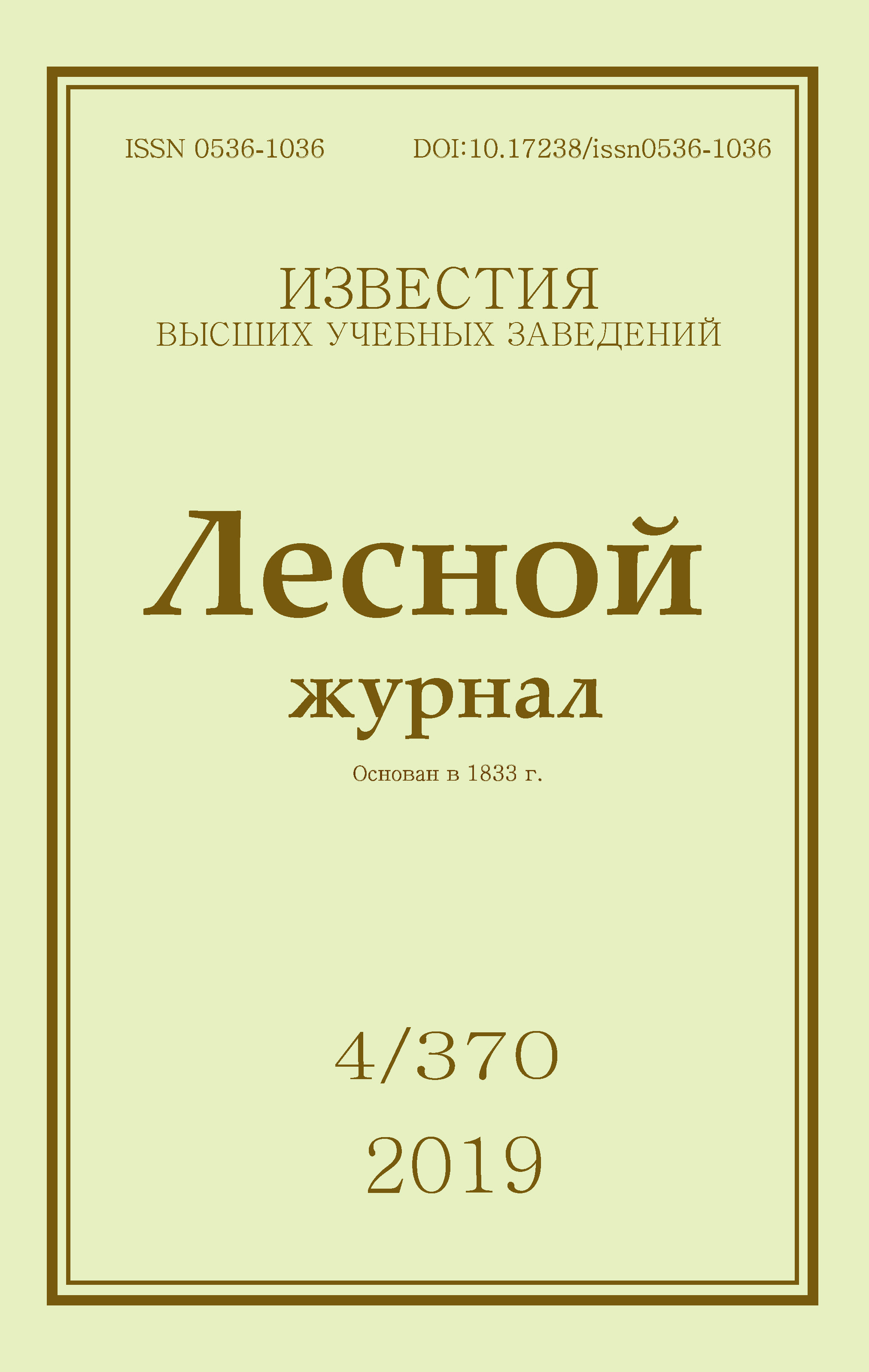Bioconversion of the Cellulose-containing Materials in the Arctic Region Conditions
DOI:
https://doi.org/10.17238/issn0536-1036.2019.4.179Keywords:
biodegradation of cellulose-containing materials, bacterial cellulose, enzymatic hydrolysis, celluloseAbstract
The regions of the Far North and the Arctic (the territory of which includes the Arkhangelsk region) are characterized by extreme natural and climatic factors: low temperatures in winter, a large daily temperature drop, frequent snowstorms in winter and rains in summer. These conditions significantly affect the enzymatic activity of soil microorganisms. The aim of the work is to assess the effect of the enzymatic treatment temperature on the initial stages of biodegradation of the cellulose – containing materials. The study used samples of cardboard and paper products: newspaper paper with color printing, container cardboard and white office paper. Bacterial cellulose was obtained by cultivating a symbiosis of the genus Acetobacter bacteria and yeast on a glucose medium in static conditions at 25 °C. to simulate biodegradation, a laboratory enzyme preparation was used, produced by a strain of a microscopic fungus. The activity of soil cellulases initiating bioconversion of cellulose-containing materials in soils of municipal solid waste storage areas of the Arkhangelsk region was low and amounted to less than 10 μg of glucose/10 g of soil per 48 hours of exposure. The determining factor for the bioconversion process in the Arctic region is the soil temperature. It is shown that while a decrease in temperature to 5...15 °C, the bioconversion rate of cellulose-containing materials of plant origin is reduced by 2...8 times compared to the temperature of 30...50 °C, which is optimal for many enzymatic processes. It was found that bioconversion of bacterial cellulose to glucose is weakly dependent on the temperature of enzymatic treatment in the range of 5...15 °C and averages 20% for 1 day.
For citation: Bolotova K.S., Travina O.V., Aksenov A.S., Emelyanova M.V., Rudakova V.A., Kanarskiy A.V. Bioconversion of Cellulose-containing Materials in the Arctic Region Conditions. Lesnoy Zhurnal [Forestry Journal], 2019, no. 4, pp. 179–186. DOI: 10.17238/issn0536-1036.2019.4.179
Funding: The research was financed by the RFBR within the framework of the scientific project № 18-33-00855 “The supramolecular organization of the cellulose microfibrils of phytogenous and bacterial origin” hardware-assisted by the “Arctic” SC of the Northern (Arctic) Federal University named after M.V. Lomonosov, with the use of enzymatic agent provided by the Institute of biochemistry named after A.N. Bach.
*The article was published in the framework of implementation the development program of scientific journals in 2019.
Downloads
References
Алимова Ф.К., Тухбатова Д.И., Тазетдинова Д.И. Методы определения гидролаз почв и почвенных микроорганизмов: учебно-метод. пособие. Казань: Казан. ун-т, 2010. 67 с.
Болотова К.С., Новожилов Е.В. Применение ферментных технологий для повышения экологической безопасности целлюлозно-бумажного производства // Химия растительного сырья. 2015. № 3. C. 5–23. DOI: https://doi.org/10.14258/jcprm.201503575
Болотова К.С., Чухчин Д.Г., Майер Л.В., Гурьянова А.А. Морфологические особенности фибриллярной структуры растительной и бактериальной целлюлозы // Лесн. журн. 2016. № 6. C. 153–165. (Изв. высш. учеб. заведений). DOI: 10.17238/issn0536-1036.2016.6.153
Оболенская А.В., Ельницкая З.П., Леонович А.А. Лабораторные работы по химии древесины и целлюлозы. М.: Экология, 1991. 320 с.
Технология целлюлозно-бумажного производства: в 3 т. Т. 1. Сырье и производство полуфабрикатов. Ч. 2: Производство полуфабрикатов. СПб.: Политехника, 2003. 633 с.
Титова В.И., Козлов А.В. Методы оценки функционирования микробоценоза почвы, участвующего в трансформации органического вещества. Н. Новгород: Нижегородская гос. с.-х. академия, 2012. 64 с.
Чекушина А.В. Целлюлолитические ферментные препараты на основе грибов Trichoderma, Penicillium и Myceliophtora с увеличенной гидролитической активностью: автореф. дис. ... канд. техн. наук. М.: Ин-т биохимии им. А.Н. Баха РАН, 2013. 23 с.
Чертовской В.Г. Еловые леса европейской части СССР: моногр. М.: Лесн. пром-сть, 1978. 176 с.
Chatterjee S., Sharma S., Prasad R.K., Datta S., Dubey D., K Meghvansi M.G., Vairale M., Veer V. Cellulose Enzyme Based Biodegradation of Cellulosic Materials: An Overview (2015). South Asian J Exp. Biol., 5 (6), pp. 271–282, DOI: https://doi.org/10.1007/978-981-10-7485-1_14
Kadere T.T., Miyamoto T., Oniang`o R.K., Kutima P.M., Njoroge S.M. Isolation and Identification of the Genera Acetobacter and Gluconobacter in Coconut Toddy (Mnazi). African J Biotechnol, 2008. Vol. 7 (16). Pp. 2963–2971.
Kawecki M., Krystynowicz A., Wysota K., Czaja W., Sakiel S. et al. Bacterial Cellulose Biosynthesis, Properties and Applications. Proceedings of the International Review Conference Biotechnology, Vienna, Austria, 2004. Pp. 14–18.
Lynd L.R, Weimer P.J., van Zyl W.H., Pretorius I.S. Microbial Cellulose Utilization: Fundamentals and Biotechnology Microbiol Mol Biol Rev, 2002. vol. 66(3), pp. 506–577. DOI: 10.1128/MMBR.66.3.506-577.2002
Ojumu T., Solomon V., Bamidele O., Betiku E., Layokun S.K, et al. Cellulose Production by Aspergillus Flavus Linn Isolate NSPR 101 Fermented in Sawdust, Bagasse and Corncob. African J Biotechnol, 2003. vol. 2, pp. 150–152.
Perez J., Munoz-Dorado J., Rubia T. de la, Martınez J. Biodegradation and Biological Treatments of Cellulose, Hemicelluloses and Lignin: an overview. International Microbiology, 2002. vol. 5, isue 2, pp.53–63, DOI: https://doi.org/10.1007/s10123-002-0062-3
Wierzba S., Nabrdalik M. Biodegradation of Cellulose in Bottom Sediments of Turawa lake. Physicochemical Problems of Mineral Processing, 2007. vol. 41 (1), pp. 227–235.
Поступила 19.09.18







